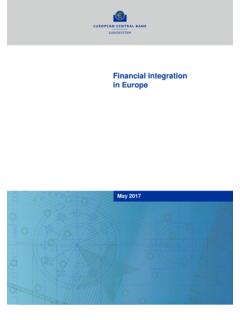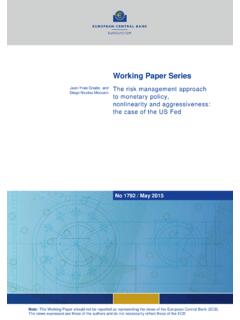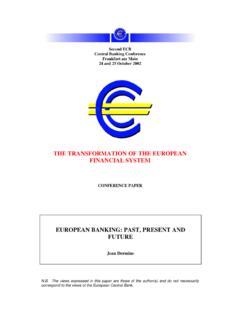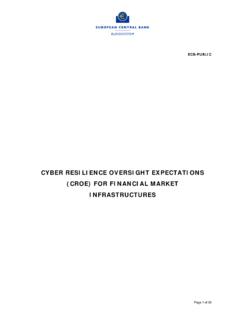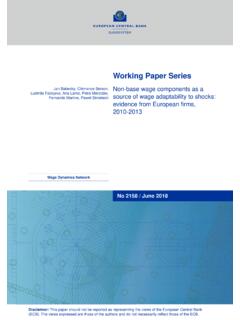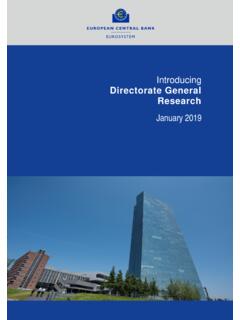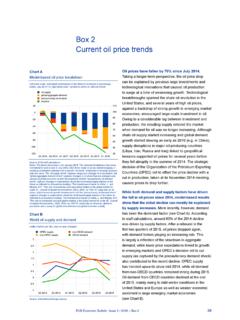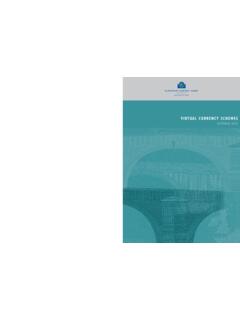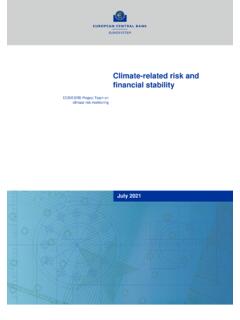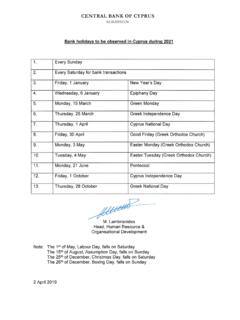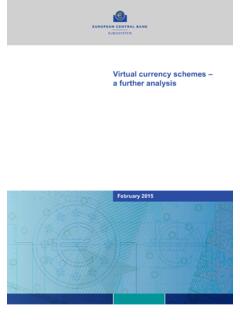Transcription of Study on the payment attitudes of ... - European Central Bank
1 SPACE is dedicated to Hannah Schwabl ( ), a dedicated and cheerful ECB colleague, who was deeply involved in the initial stage of the work on this Study . Study on the payment attitudes of consumers in the euro area (SPACE) December 2020 Study on the payment attitudes of consumers in the euro area Contents 1 Contents Foreword 4 Executive summary 5 Introduction 8 1 Research method 9 Scope 9 Sample design 9 Data collection 12 Box 1 payment surveys in Germany and in the Netherlands 13 Weighting 14 Validation of the data 14 Box 2 Combining telephone and online interviews to reduce bias 15 2 Payments at the point of sale and to individuals 17 Total number and value of POS and P2P payments per payment instrument and their relative share per country 17 Box 3 Survey on the impact of the pandemic on cash trends 21 Daily average of
2 POS and P2P payments 25 The use of contactless technology for card payments 29 Total number of POS and P2P transactions per value range and payment instrument 30 Total number and value of POS and P2P transactions by place of purchase and payment instrument 32 3 Remote payments 34 E-shopping, telephone and mail orders 34 Bill payments and recurring payments in the euro area 43 4 Consumers use cash (in particular high-value banknotes) as a store of value 50 Extra cash stored 50 Possession of high-value banknotes 54 Study on the payment attitudes of consumers in the euro area Contents 2 5 Factors influencing payment behaviour 57 Consumers payment preferences 57 Access and acceptance 63 Cash balances in consumers wallets 70 6 How consumers obtain cash 72 Topping up of consumers wallets 72 Receiving regular income in cash 75 7 Concluding remarks 77 Annex A 78 Diary survey questionnaire 78 Accompanying questionnaire 86 Annex B 90 Euro area 90 Austria 93 Belgium 96 cyprus 99 Estonia 102 Spain 105 Finland 108 France 111 Greece 114 Ireland
3 117 Italy 120 Lithuania 123 Luxembourg 126 Latvia 129 Malta 132 Portugal 135 Study on the payment attitudes of consumers in the euro area Contents 3 Slovenia 138 Slovakia 141 List of references 144 Study on the payment attitudes of consumers in the euro area Foreword 4 Foreword Retail payments have to be reliable, efficient and inclusive in order to maintain confidence in the euro. In the digital age, innovation in retail payments is influencing the way people pay. In view of the continuing transformation towards a more digital payment landscape, the eurosystem is committed to carefully monitoring new trends and the nature and extent of the changes in consumers payment preferences.
4 In 2019 the ECB launched a new survey to investigate the payment behaviour of euro area citizens. The results are described in this report, together with provisional findings on how consumers paid during the initial phase of the coronavirus crisis. The survey results indicate that cash is still the most used retail payment instrument in the euro area, but cashless means of payment are increasing their share across euro area countries, albeit at varying speeds. The trend towards cashless payments seems to have accelerated during the pandemic, although the consolidation of this provisional finding is still uncertain. The evidence presented in this report will help the eurosystem to understand actual consumer demand and evolving market trends and facilitate the implementation of the eurosystem s cash and payment strategies.
5 These strategies entail fostering competitive and innovative pan- European market solutions, while guaranteeing that efficient and resilient payment options remain available to all euro area citizens. For cash, this commitment has been laid down in the eurosystem s Cash 2030 strategy, which aims to ensure access to and the acceptance of cash in the euro area. Guaranteeing and enhancing consumers freedom to choose their payment method and the financial inclusion of all groups in society are of the utmost importance to us. Fabio Panetta ECB Executive Board Member Study on the payment attitudes of consumers in the euro area Executive summary 5 Executive summary In 2019, the European Central bank (ECB) conducted a Study on the payment attitudes of consumers in the euro area (hereafter referred to as SPACE).
6 This report presents the key SPACE results and compares them, to the extent possible, with an earlier ECB Study conducted in 2016, the Study on the use of cash by households in the euro area or SUCH (Esselink and Hern ndez, 2017). SPACE assesses consumers use of cash and non-cash payment instruments at the level of each participating euro area country and for the euro area as a whole. The scope of SPACE includes purchases by individuals at the physical point of sale (POS) and person-to-person (P2P) payments, as well as payments made remotely ( for online shopping, telephone orders and mail orders, bill payments and recurring payments).
7 SPACE also explores the factors influencing individuals payment attitudes and behaviour. Such factors are consumers self-reported payment preferences, as well as consumers access to and merchants acceptance of payment instruments. SPACE fieldwork was conducted in 2019. Between mid-March 2019 and mid-December 2019, 41,155 respondents in 17 euro area countries reported their transactions in one-day payment diaries. The payment diaries of 2,061 respondents in Germany and 22,103 respondents in the Netherlands collected in the context of national surveys in 2017 and 2019 respectively were included in the SPACE analysis where possible (see De Nederlandsche bank , 2020, and Deutsche Bundesbank, 2018).
8 While payment diary data for Germany stem from 2017, the Deutsche Bundesbank collected some survey data in 2019 (see Box 1) in parallel to the ECB survey. The SPACE results (including Dutch and German data) show that: consumers still predominantly use cash for POS and P2P payments: 73% of the volume of POS and P2P transactions was carried out using cash as a payment instrument and 27% using non-cash payment instruments; cards were the predominant payment instrument used for cashless payments (24%); this compares with a cash usage of 79% in terms of the number of transactions and a card usage of 19% reported in the previous study1 (SUCH); among all card payments, 38% of the transactions were made using contactless technology.
9 In value terms, cash transactions accounted for 48% of all transactions, versus 41% for card transactions; 1 In the previous Study , P2P transactions were not part of the scope and online transactions were included. Study on the payment attitudes of consumers in the euro area Executive summary 6 euro area citizens made on average POS and P2P transactions per day, with an average transaction value of ; 48% of the POS and P2P transactions were conducted in local shops for day-to-day retail purchases (shops, supermarkets, street markets) and 19% in restaurants, bars, caf s and hotels. Excluding Germany, for which comparable data on remote payments ( online and bill payments) are not available, the SPACE results also show that: 96% of all online transactions were cashless, using cards (49% of the online transactions), e- payment solutions (27%) and credit transfers (10%); cash was used in 4% of the online transactions2; euro area citizens made on average online transactions (using the internet, including also telephone and mail purchases) per day, with an average value of ; 89% of all bill payments were cashless.
10 41% of the bill payments were made using direct debit and 20% using credit transfer as the payment method; 11% of the bill payments were in cash; euro area citizens made on average slightly less than one bill payment per week ( transactions). Consumers self-reported preferences for payment instruments contrast with the actual high usage of cash, as there seems to be a preference for using cashless payment instruments. Almost half (49%) of the respondents stated that they preferred using cards or other cashless payment instruments (up from 43% in 2016 according to SUCH), whereas 27% said that they preferred cash (down from 32% in 2016), while the remaining 24% said that they were indifferent.
